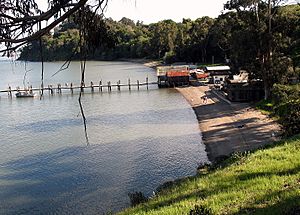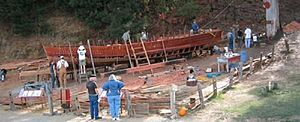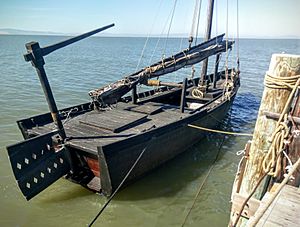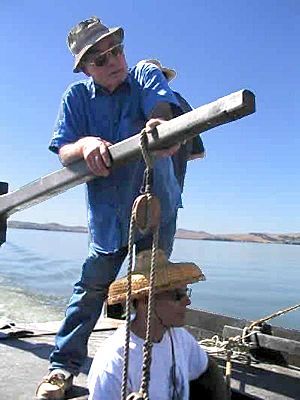Grace Quan facts for kids

Grace Quan prepared to sail
|
|
| History | |
|---|---|
| Owner | San Francisco Maritime National Historical Park and China Camp State Park |
| Builder | Park employees and volunteer labor |
| Laid down | April 24, 2003 |
| Launched | October 25, 2003 |
| Status | Museum ship |
| General characteristics | |
| Class and type | Chinese-American shrimp fishing junk |
| Length | 42 ft 3 in (12.88 m) |
| Beam | 10 ft 4 in (3.15 m) |
| Draft | One foot with rudder and daggerboard up, five feet with rudder and daggerboard down |
| Propulsion | Sail or oars |
| Sail plan | Single masted catboat, traditional cotton sail with six battens |
The Grace Quan is a special boat that looks just like the old Chinese-American shrimp fishing boats called junks. These junks used to sail in San Francisco Bay a long time ago, in the late 1800s and early 1900s.
This boat was built in 2003. It was a team effort between China Camp State Park and the San Francisco Maritime National Historical Park. Now, both parks share and operate the Grace Quan. It's like a "working museum" that sails! Its main job is to teach people about the history of Chinese-American immigrants in California, a story that was almost forgotten.
Contents
San Francisco Bay's Shrimp Fishing History
Shrimp fishing in San Francisco Bay started around 1869 with Italian fishermen. Chinese fishermen joined in 1871, using special bag nets from China. Soon, many Chinese immigrants from Guangdong became the main shrimp fishermen in Northern California. They also fished in Tomales Bay, but those fishing spots closed in the 1890s.
Chinese shipbuilders built these unique junks right here in California. They used old traditions and local wood. By the late 1800s, dozens of these Chinese shrimp fishing junks were busy on the bay. They caught huge amounts of shrimp, sometimes as much as nine to ten million pounds each year!
Most of the shrimp caught were boiled and dried. This made them last a long time, so they could be sent to China and Hawaii. Dried shrimp was used for food. The leftover parts, called shrimp meal, were used for fish food or plant fertilizer.
Challenges for Chinese Fishermen
Around 1885, some people started to complain about the Chinese fishermen. They worried that the Chinese nets were catching too many young fish, like salmon and striped bass, by mistake. This was called "bycatch." This problem was made worse by strong anti-Chinese feelings in California at that time.
Later studies showed that these worries were not entirely true. The fishermen often ate or gave away any edible fish they caught. A report in 1932 even said that "the average striped bass is too spry to be taken in any such rig."
Still, new rules were put in place. In 1901, the fishing season was closed for four months each year. In 1905, it became illegal to send dried shrimp out of California. Then, in 1911, Chinese nets were banned. This forced fishermen to switch to different nets and use motorized boats instead of sailing junks. Many Chinese fishing crews were arrested in the early 1900s. The ban on exporting dried shrimp was lifted in 1919, which helped fishing grow again in the 1920s.
The Fishery's Decline
By 1930, about 2.6 million pounds of shrimp were caught in the bay. There were 35 boats and 72 men working. Most boats were now motorized, with only a few traditional sailing junks left. There were 12 shrimp fishing camps in San Francisco and two in Marin County, including China Camp.
The shrimp fishing business slowed down a lot after 1936. This was because of the Great Depression (a time when the economy was very bad) and wars in China. After World War II, shrimp fishing was mostly for local sales, like selling shrimp for fishing bait.
A third-generation Chinese-American shrimp fisherman named Frank Quan continued to fish for shrimp in small amounts into the 21st century. He lived at China Camp until he passed away just before his 91st birthday.
Building the Grace Quan
The idea for building the Grace Quan started in 1995. A student named John Muir found an old photo of a Chinese junk sailing in San Francisco. John Muir is a distant relative of the famous nature lover, John Muir.
While studying for his master's degree, Muir dug up parts of two old junks at China Camp. He measured them carefully. He also visited shipyards in China that still build wooden fishing boats the old way. Muir later became a boat expert at the San Francisco Maritime National Historical Park. He then suggested building a new junk that looked just like the old ones built in California, using the same materials and methods.
How the Grace Quan Was Built
Muir helped the two parks agree to build the junk using volunteers. They used redwood lumber for most of the boat's body. This wood was donated by a group that protects nature.
Building started in March 2003. They used traditional Chinese shipbuilding methods. For example, they would heat planks with fire to bend them into shape. They also used special hand-forged nails. The gaps between the wooden planks were sealed with a traditional caulk called chu'nam. This was made by volunteers using a mix of lime, linseed oil, and natural fibers like animal hair or bamboo.
The main support beam, called the keel, was put in place on April 24, 2003. The junk was launched into the water on October 25, 2003. At the launch party, it was announced that the boat would be named Grace Quan, in honor of Frank Quan's mother.
Grace Quan Specifications
The Grace Quan is about 42 feet 3 inches (12.88 m) long. Its beam (width) is about 10 feet 4 inches (3.15 m). It has a single mast and is called a catboat.
When its daggerboard and rudder are down, the boat's draft (how deep it sits in the water) is 5 feet (1.5 m). When they are pulled up, the draft is only 1-foot (0.30 m).
The boat is built with wood from California. The keel, planks, frames, and deck are made of redwood. The mast, stem, thwarts (seats), and oars are made of Douglas fir. The mast came from an 80-foot-tall Douglas fir tree in Napa County.
The Grace Quan has special oars. One is a traditional Chinese sculling oar called a yuloh, used from the back of the boat. There are also two oars that can be used from the front. These oars helped old shrimp fishing junks move around their nets when there was no wind.
The boat's sail is made of cotton. It's treated with tanbark oak, which helps protect it from the weather and gives it a special tan color. The sail also has six wooden battens, which are strips of wood that help it keep its shape.
How Grace Quan Is Used Today
In 2005, the Grace Quan sailed from San Francisco Bay all the way to Sacramento. Schoolchildren were able to visit and tour the boat there.
The junk stays at the San Francisco Maritime National Historical Park's Hyde Street Pier in the winter. In the summer, it moves to China Camp State Park in San Rafael. It sails between these two places twice a year, a trip of about 15 nautical miles.
In 2014, the Grace Quan took a special trip around San Francisco Bay. It visited the places where many historic Chinese immigrant shrimp fishing villages used to be. These stops included Richmond, California, Hunters Point in San Francisco, and Redwood City, California in the south bay.
Why Grace Quan Is Important
When the junk was being built, a historian named Phil Choy said that this project helps show that Chinese immigrants were not just laundrymen or cooks. He said, "They had know-how. They were enterprising and resourceful."
Rene Yung, who leads a cultural group, said in 2014 that the history of Chinese immigrants in America often had their contributions forgotten. She explained that the busy Chinese shrimping industry around San Francisco Bay is one of these forgotten stories. She described the Grace Quan's voyages as a way to honor "this pioneer community and San Francisco’s maritime heritage."





